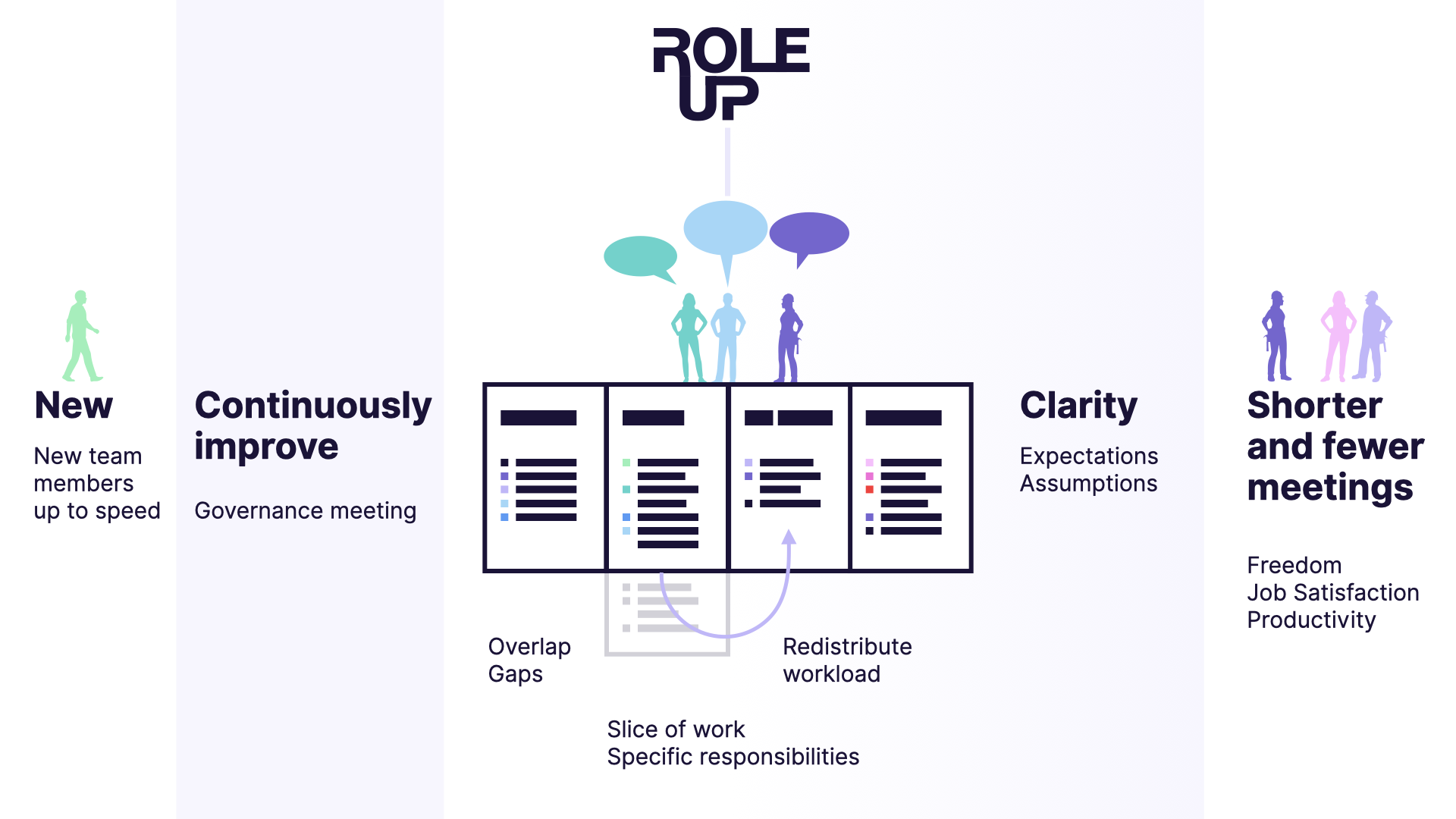
Introduction to Working with Roles
A brief introduction to bring you up to speed in 2 minutes. What are Roles? How can you work with Roles? How are they used for self-management in Holacracy and sociocracy, and how can working with Roles benefit your team?
What are Roles?
Roles are clearly defined slices of work and decision-making.
What is working with Roles?
When you work with Roles, you divide the work a team or organization needs to do into coherent packages: Roles. Each Role has a mission and gets a distinct set of responsibilities.
You delegate Roles to individuals in the team. The person filling the Role is accountable for the work defined in that Role.
One person can have multiple Roles. It is also possible for several people to fill the same Role.
Roles versus functions
Roles are typically smaller than traditional functions. They are also dynamic. A function profile is often a static description created by someone else, whereas the people who do the work define a Role. They keep the Role up-to-date in regular governance meetings. Therefore Roles are more agile than traditional functions.
How is working with Roles different?
Roles are explicit and transparent to everyone in the organization. All your colleagues can see what your responsibilities are. Clearly defined Roles make it easy to find the accountable person in your organization.
When working with Roles, it becomes straightforward to distribute decision-making power to experts in your organization. Any Role in any team can be made accountable for a specific part of the work. Allocating decisions to experts in the organization allows a company to react faster and become more agile.
Roles in Holacracy and sociocracy
Holacracy and sociocracy are contemporary “operating systems” for organizations. These are frameworks that companies can use to organize themselves and the work they do. Both Holacracy and sociocracy help organizations distribute decision-making power. They replace the traditional hierarchical command-and-control structure with self-management.
Sociocracy and Holacracy both use Roles as the building blocks for organizations. But you can enjoy the benefits of working with Roles without practicing Holacracy or sociocracy. Working with Roles can benefit a single team, a department, or even an entire organization without Holacracy or sociocracy.
How will working with Roles benefit your team?
Working with Roles brings advantages for people, teams, and organizations. Both individuals and (multi-disciplinary) teams benefit from the clarity that Roles bring to the job. When you start working with Roles, you can achieve
- Reduced irritations between team members
- Less conflict
- More effective communication
- Shorter meetings
- Fewer meetings
- Increased productivity
- Better workload balance
- Increased job satisfaction
- Longer employment
On an organizational level, you will also benefit from a more dynamic org chart. An overview of all teams that makes all responsibilities in your organization transparent for everyone. A single source of truth that is up to date and as agile as your teams. With the organic flexibility to grow with your organization.
In our resources, you will find more in-depth explorations of the benefits and best practices of working with Roles for individuals, teams, and organizations.

Last updated on
More Resources
-
Workshop: Start working with Roles
This easy-to-follow guide will help you to organize a workshop for your team. You will create and assign roles and list responsibilities. Open workshop guide -
How to run an effective
Once your team has defined its Roles and responsibilities, how do you keep them up-to-date? The answer is a recurring governance meeting! Read on to learn what a governance meeting is and how to run one effectively. Run effective governance meetings
Governance Meeting -
Working with Roles as a team
How can teams use Roles to work better together? What are the benefits of working with Roles for teams? How can working with Roles help your team to reduce friction and irritation, improve communication, have fewer meetings, and deliver more value?
Read about working with Roles as a team -
Why every Agile team
should use Role-up
Watch our video about why every team that works agile should use Role-up and experience the advantages of working Role-based.
See why every agile team should use Role-up -
Organizations work better with Roles
How can organizations benefit from working with Roles? How can they scale and grow more agile with Roles? How does working with Roles enable companies to distribute decision-making authority and become more resilient? And why is that a good thing for a founder or CEO?
Learn how organizations benefit from Roles -
Seven reasons organizations start working with Roles
A growing number of organizations have switched to some form of self-management. This can be Holacracy, sociocracy, or other practices. What makes these companies transition to working with Roles? What frustrations and annoyances motivate this change?
Find out what we discovered -
Retrospective: Roles and Responsibilities
Does your scrum team have team members who avoid talking to each other? Is passive-aggressive behavior getting in the way of good teamwork? Are there irritations between team members? This article provides a Role-based sprint retrospective format that helps your team work better together.
Check out the exercise -
Get help from a Professional
There are professionals who can help you with setting up Roles, creating robust governance structures, and improving how you work together with your team.
View the list of professionals








